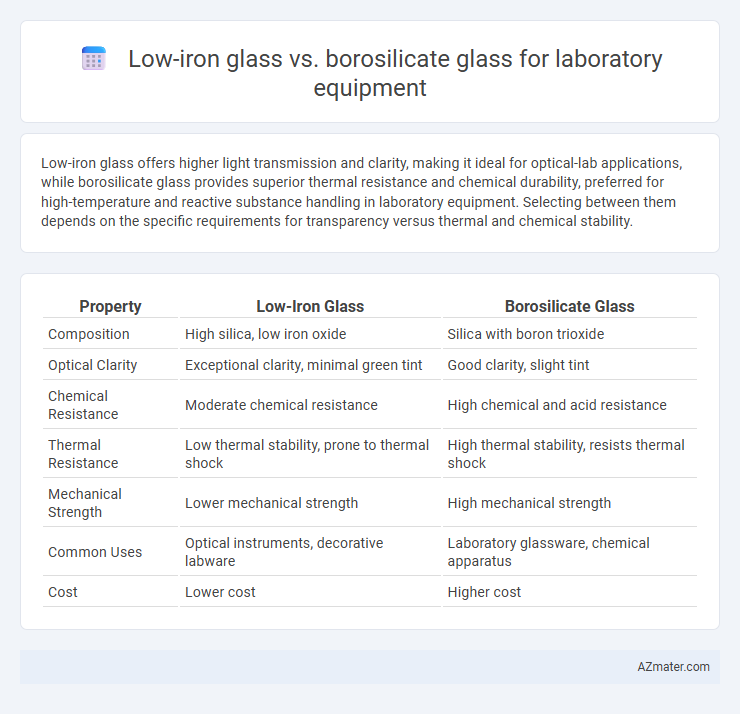Low-iron glass offers higher light transmission and clarity, making it ideal for optical-lab applications, while borosilicate glass provides superior thermal resistance and chemical durability, preferred for high-temperature and reactive substance handling in laboratory equipment. Selecting between them depends on the specific requirements for transparency versus thermal and chemical stability.
Table of Comparison
| Property | Low-Iron Glass | Borosilicate Glass |
|---|---|---|
| Composition | High silica, low iron oxide | Silica with boron trioxide |
| Optical Clarity | Exceptional clarity, minimal green tint | Good clarity, slight tint |
| Chemical Resistance | Moderate chemical resistance | High chemical and acid resistance |
| Thermal Resistance | Low thermal stability, prone to thermal shock | High thermal stability, resists thermal shock |
| Mechanical Strength | Lower mechanical strength | High mechanical strength |
| Common Uses | Optical instruments, decorative labware | Laboratory glassware, chemical apparatus |
| Cost | Lower cost | Higher cost |
Introduction to Laboratory Glass Types
Low-iron glass offers enhanced clarity and brightness, making it ideal for visual applications in laboratory equipment where color neutrality is critical. Borosilicate glass is renowned for its exceptional thermal resistance, chemical durability, and mechanical strength, ensuring reliability under extreme laboratory conditions. Selecting between low-iron and borosilicate glass depends on the specific requirements of chemical resistance, thermal stability, and optical clarity in scientific experiments.
What is Low-Iron Glass?
Low-iron glass is a type of glass with reduced iron content, resulting in higher light transmission and enhanced clarity compared to standard glass. It is commonly used in laboratory equipment where optical clarity and minimal color distortion are crucial for accurate observations and measurements. Unlike borosilicate glass, which is valued for its thermal resistance and chemical durability, low-iron glass primarily excels in applications requiring superior visual transparency.
What is Borosilicate Glass?
Borosilicate glass is a type of laboratory glass known for its exceptional thermal resistance and chemical durability, composed primarily of silica and boron trioxide. Unlike low-iron glass, borosilicate glass can withstand rapid temperature changes and exposure to corrosive chemicals, making it ideal for lab equipment such as beakers, test tubes, and flasks. Its low thermal expansion coefficient reduces the risk of cracking under heat, ensuring reliability in precise scientific experiments.
Chemical Composition Comparison
Low-iron glass contains a reduced amount of iron oxide, typically less than 0.01%, enhancing its transparency and reducing discoloration in laboratory equipment. Borosilicate glass, composed primarily of silica (SiO2) and boron trioxide (B2O3), offers superior thermal resistance and chemical durability due to its unique composition. The low-iron variant prioritizes optical clarity, whereas borosilicate glass balances chemical resistance with mechanical strength, influencing their application based on experimental requirements.
Optical Properties and Clarity
Low-iron glass exhibits superior optical clarity compared to standard glass due to its reduced iron content, resulting in higher light transmission and minimal greenish tint, which is critical for precise visual observations in laboratory equipment. Borosilicate glass, while known for its excellent thermal and chemical resistance, typically contains more iron, leading to slightly lower optical clarity and a subtle coloration that may affect the accuracy of optical measurements. For applications demanding high transparency and minimal color distortion, low-iron glass is preferred, whereas borosilicate glass offers a balance of clarity with enhanced durability.
Thermal Resistance and Stability
Low-iron glass offers high transparency but lower thermal resistance compared to borosilicate glass, which withstands temperatures up to 450degC due to its low thermal expansion coefficient. Borosilicate glass exhibits superior thermal stability, making it ideal for laboratory equipment exposed to rapid temperature changes and thermal shocks. The enhanced durability of borosilicate reduces risks of fracturing, ensuring precision and safety in scientific experiments.
Chemical Resistance and Durability
Low-iron glass exhibits moderate chemical resistance and is prone to minor ion exchange, making it less durable under harsh chemical exposures compared to borosilicate glass. Borosilicate glass contains boron trioxide, providing superior chemical resistance to acids, bases, and thermal shock, ensuring long-term durability in rigorous laboratory environments. The enhanced durability and resistance characteristics of borosilicate glass make it the preferred choice for laboratory glassware requiring reliability and longevity.
Cost and Availability
Low-iron glass offers a cost-effective option with widespread availability, making it suitable for general laboratory applications that do not require extreme chemical resistance. Borosilicate glass, though more expensive, provides superior thermal and chemical durability, commonly used in laboratories where precision and heat resistance are critical. Availability of borosilicate glass may be limited compared to low-iron glass, impacting procurement time and budget for some lab setups.
Applications in Laboratory Settings
Low-iron glass offers exceptional optical clarity and is ideal for laboratory applications requiring precise visual inspection, such as sample observation and optical experiments. Borosilicate glass provides superior thermal and chemical resistance, making it suitable for use in high-temperature reactions, acidic or alkaline environments, and general-purpose labware like beakers and flasks. Selecting between low-iron and borosilicate glass depends on the need for optical transparency versus durability under harsh chemical and thermal conditions.
Choosing the Right Glass for Your Laboratory
Low-iron glass offers superior light transmission and clarity, making it ideal for precise optical measurements and visual inspections in laboratory settings. Borosilicate glass is favored for its exceptional thermal resistance, chemical durability, and mechanical strength, suitable for harsh chemical reactions and high-temperature applications. Choosing the right glass depends on whether clarity or resistance to thermal shock and chemical corrosion is the priority in your laboratory processes.

Infographic: Low-iron glass vs Borosilicate glass for Laboratory equipment
 azmater.com
azmater.com